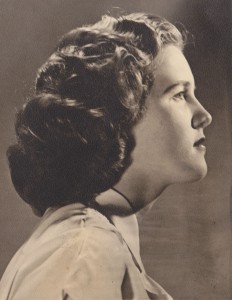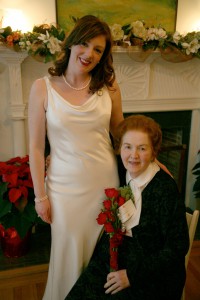When my mother was diagnosed with ALS in 2009, our family had the first of many discussions about her end-of-life plans. Never one to shy away from difficult topics, Mom expressed her wishes with characteristic cheerful directness. She wanted everything done with the least fuss and greatest economy.
The one decision that gave her pause was the photo to accompany her obituary. She didn’t want to be remembered as she looked in the late stages of ALS, but she also felt it would be “phony” to run a photo of herself in young adulthood, before marriage and motherhood. And from this question came a series of conversations between myself and my mother that I carry with me as my own appearance changes along with my sense of who I am.
In the course of a life, which image defines who you are? Was my mother the round-faced farmgirl, the fashionable Catholic school graduate, the happy young mother, or the navy-blue pantsuited Mom who, in my mind, hadn’t altered in appearance since 1972? At each stage of my own life, I’ve looked in the mirror and thought, “this is my face. That other face was the old me.” At what point does that evolution of self-image stop, and the thought takes over that “this old face isn’t me!” For my mother, it happened when she became ill.
In the course of my mother’s 76 years, she appeared in perhaps fifty photos – most from her later years. At her funeral our family displayed a collage of our favorites: a 1934 baby photo; with her young siblings; her wedding to our father; holding her babies and, later, grandchildren; visiting family in Prince Edward Island; and at her home on Cape Cod. Friends and family gathered around the collage, remarking on how well it represented Mom and her life.
With the advent of digital photography, we now have thousands of photos and videos of ourselves, from the very first to the very last moments of our lives. Will this overabundance of images make it easier for our descendants to know and understand us, or more difficult? With each moment frozen in time and given equal importance on social media, how will our descendants know which events stood out and made us who we were?
As was the case with many of her life decisions, frugality determined Mom’s choice for her obituary. On finding that inclusion of a photo involved an additional fee, she insisted we not submit one. And so she is memorialized not by an image at all, but in the sentences crafted lovingly by her family after her death about her accomplishments, intelligence, warmth, and wit – the qualities that enabled us to look past her age and infirmity and see, right to the end, that beautiful, ageless redhead with sparkling hazel eyes.
To see photos mentioned in this article, visit Jean's Facebook page.
Share this:
About Jean Powers
Jean provides editing, writing, design, illustration, and creative and strategic concepts for a variety of marketing, development, educational, and outreach projects. She assists on American Ancestors magazine, The Weekly Genealogist newsletter, the Great Migration Study Project, and our Facebook page.View all posts by Jean Powers →

